|
War in the Pacific
Asan and Agat Invasion Beaches Cultural Landscapes Inventory |

|
| PART 3b |
ANALYSIS AND EVALUATION
Natural Systems and Features
The natural systems and features that influenced the tactical planning and field logistics of the U.S. Military effort to capture the Asan and Agat beach heads were the coral reefs that surrounded the beach heads, the flat coastal plains, and the five coral outcrop points (Adelup, Asan, Apaca, Ga'an and Bangi).
The transport of troops, supplies and equipment to the beaches was difficult because of the coral reefs. Asan and Agat beaches were ideal locations to land because of the open terrain beyond the beach. Upon landing on the beaches, the troops continued inland towards higher ground east of the beachheads. Today, the coral reefs surrounding the beachheads are still intact and are contributing to the historic scene.
As the troops moved inland, the flat coastal agricultural fields became another obstacle in their drive towards higher ground. Historically, the flat coastal plains of Asan and Agat beaches overall character mostly consisted of coconut groves, limestone forest and rice paddies. Today, the rice paddies no longer exist, however, in several areas on both beach units, flat coastal areas have been replaced with tall grass and lawns which slightly resembles the character of rice paddies. Coconut trees and strands of limestone forests are still present on the landscape but not as dense as they were prior to the pre-invasion bombing by the U.S. Military.
Defensive positions were established by the Japanese troops in the coral outcrops known as Adelup, Asan, Apaca, Ga'an and Bangi points located along the Asan and Agat coast. The Japanese defensive positions strategically built into the coral outcrops included gun emplacements, caves, pillboxes and tunnels. As U.S. troops secured these five points, they moved inland towards higher ground. Today, these five points are still present and intact on the landscape and are considered contributing to the historic scene.
The coral reefs surrounding Asan and Agat beaches presently are still intact and contribute to the historic scene. Today, overall character of the flat coastal plains is also considered a contributing feature. The five points, Adelup, Asan, Apaca, Ga'an and Bangi remain intact and are also considered a contributing feature. Overall, natural systems and features contribute to the period of significance and are considered a significant characteristic of the War in the Pacific National Historical Park.
| Characteristic Feature |
Type Of Contribution |
LCS Structure Name |
IDLCS Number |
Structure Number |
| Adelup, Asan, Apaca, Ga'an and Bangi Points | Contributing | |||
| Coral Reefs Surrounding Asan and Agat Beach Head | Contributing | |||
| Flat Coastal Plains of Asan and Agat Beach Units | Contributing | |||
Spatial Organization
The spatial organization of Asan and Agat battlefields centered on offensive and defensive strategies using the natural features of the terrain. The spatial relationship between coral reefs and beaches, coastal flats and the beach, and the cluster of Japanese defense structures in the rocky outcroppings influenced American invasion plans and Japanese military strategies.
Organization of American Offense and Japanese Defense Strategies The beaches of Asan and Agat were chosen as the best place for American troops to land and bring equipment and supplies ashore. Once U.S. troops had secured both beaches, they begin pushing towards higher ground through the coastal flats. Because securing high ground was an essential part of the invasion strategy, the primary objective for the American forces was to first establish a foothold on the beaches then advance inland. Strategic planning spatially divided Asan Beach into four sections, Beach Red 1, Beach Red 2, Beach Green, and Beach Blue (see military planning map and graphic division map at end of this section). Agat Beach was divided into four sections between Apaca Point and Bangi Point: Yellow 1, Yellow 2, White 1, and White 2.
Both Asan and Agat beaches are crescent-shaped with coral limestone peninsulas that clearly define their north and south boundaries. These points have sometimes been referred to as "devil's horns". On Asan Beach, the eastern horn is named Adelup Point, but has also been known as Devil's Point (U.S. Dept. of the Interior 1944). The western point is Asan Point. On Agat Beach, the southern point is Bangi Point, the Northern Point is Apaca Point, and one in the center is Ga'an Point. These coral outcroppings provided excellent places for defensive positions and structures. These structures were most often caves, natural and blasted into the rock. They were also effective because once the American troops were ashore, the Japanese moved back into these positions. These rock outcroppings that overlooked the landing beaches guided American invasion plans and offensive military strategies and were an ally to the Japanese defense. These rock outcroppings were not destroyed during the U.S. Military pre-invasion bombardment and were not destroyed during the U.S. Military effort to recapture Guam.
Battle
Coral formations Asan Beach guided the landing path of troops and amphibious equipment. On invasion day (W-Day), reef formations provided a surface to mount the cranes that were used to unload LVT's, troops, and supplies from ships. Foreseeing this situation, the Japanese designed and built offshore defensive structures from wooden poles and barbed wire. U.S. Navy Underwater Demolitions Teams (UDT's) worked for four nights, prior to the invasion, to clear these obstacles. Ironically, the uneven reef at Agat created more of a landing obstacle and provided another opportunity for the Japanese. Brutal mortar and artillery fire bombarded U.S. troops as they crept across the reef towards the shore.
Once ashore, many soldiers were totally exposed to enemy fire. Much of the beachhead was coral rock in which not even the shallowest foxhole could be dug. After the first day, beaches were secure and troops advanced toward higher ground while shore parties worked around the clock to clear the debris from the beaches. The Seabees had set up five large cranes along the reef line to begin transferring complete cargo from supply ships to the shore. Once on shore, U.S. troops began to immediately move up the beaches toward higher ground bringing with them artillery and supplies to the front lines and retrieve the wounded that were transferred out to medical ships.
Summary
The spatial organization of the battlefield was most influenced by the natural terrain. Both the offensive and defensive military strategies were planned around the existing landscape and the five limestone outcroppings on Asan and Agat beaches. The spatial relationship between the coral reefs, beaches and coastal plains and the organization of the U.S. and Japanese military strategies that influenced the outcome of the recapture of Guam is still intact and contributing to the historic scene. The spatial relationship of the cluster of Japanese defense structures in the five coral outcrops (Adelup, Asan, Apaca, Ga'an and Bangi points) is also still intact and contributing to the historic scene. Therefore, spatial organization is a contributing characteristic of the War in the Pacific National Historical Park.
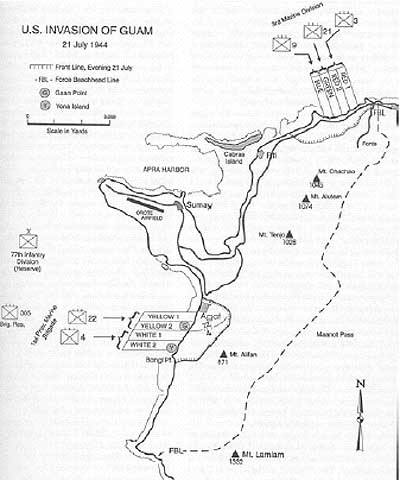
Military map planning invasion strategies on Asan and Agat beaches
(Lodge 1998:48).

Graphic division of Asan and Agat beaches for landing strategies
(Lodge 1998:34-53).
Topography
The topography within the Asan and Agat beach units range from reef shelf and level beachfront to the elevated rises of Asan, Adelup and Apaca Point and scattered limestone outcrops along the shoreline. The natural topography was used to the advantage of both the American and Japanese troops. The broad expanse of beachfront was leading to the level coastal plain provided an ideal terrain for the initial American assault on the island. The commanding strongholds were initially used by the Japanese to establish their defensive positions. The ridges and limestone outcrops were ideal for developing pillboxes and gun emplacements. The American troops immediately sought out these locations and eventually took them under their control. The steep ridges proved dangerous and deadly for the American troops who were moving to claim the high ground within the Asan and Agat Beach Units (Asan Ridge, Adelup and Apaca points), yet once they ascended the slopes and took possession of these areas, they were able to develop their own defensive strongholds that lead to the establishment of the American Force Beachhead Line (FBL).
Prior to the military manipulation of the landscape, changes to the topography were minimal and primarily involved the excavation of irrigation systems for agricultural fields. Changes to the topography during the period of significance included numerous bomb craters, the excavation associated with defense structures such as pillboxes and gun emplacements, and the building of roads. Today pillboxes and gun emplacements are still present on the landscape and scattered throughout the two beach units. Marine Drive, a six-lane highway, was constructed during the war effort and is still present today as a sixlane highway. The alterations to the topography during the period of significance are mostly still evident and contribute to the historic scene.
Historically, rivers ran perpendicular with the beaches and created natural cuts into the terrain. These cuts were a disadvantage to the American troops because it prevented them from making physical contact with other troops which influenced the initial invasion effort. These rivers are currently present and contribute to the historical scene.
Today, changes to the topography since the period of significance have been minimal. The man-made topographical alterations (i.e. bomb craters) have since been filled with soil or debris; however, other alterations to the topography such as the building of defense structures into ridges and limestone outcrops are still evident today. As a result, topography in the Asan and Agat beach units retains integrity and is contributing to the historic scene.
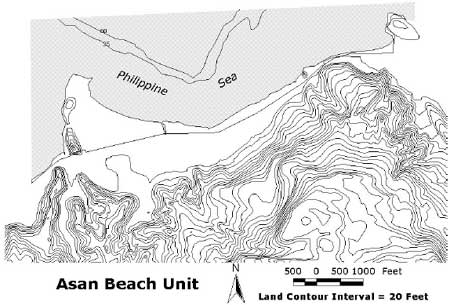
Topographical map of the Asan Beach Unit and offshore reefs (CLI
Team/PISO/2001).
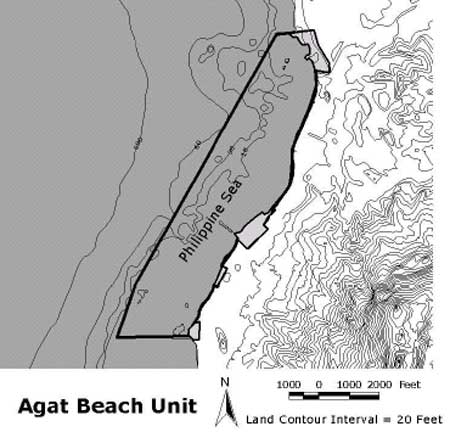
Topographical map of the Agat Beach Unit and offshore reefs (CLI
Team/PISO/2001).

Historic aerial photograph showing how the surrounding hills and
ridges form an enclave around Asan Beach (U.S. Marine Corps 1944).
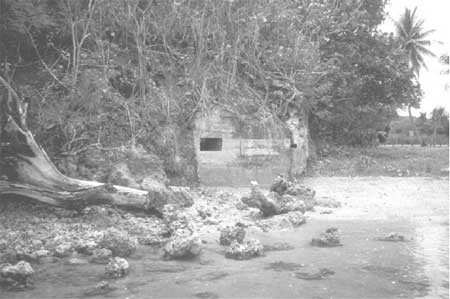
Contemporary photo of a recessed defense structure built into the
western side of Asan Ridge (CLI Team/PISO/2001).

Contemporary photo of a recessed defense structure built into a
limestone outcrop on the Agat Beach Unit (CLI Team/PISO/2001).
| Characteristic Feature |
Type Of Contribution |
LCS Structure Name |
IDLCS Number |
Structure Number |
| Altered Ridges with Defense Structures | Contributing | |||
| Excavation Associated with the Building of Marine Drive | Contributing | |||
| Limestone Outcrops with Defense Structures | Contributing | |||
| Natural Cuts into the Topography by Rivers | Contributing | |||
Views And Vistas
The important views historically were short-range views from the Philippine Sea toward the beaches and vice-versa, long-range views from the sea and beaches toward high ground (hills, ridges and mountains) and vice versa, and the short-range views in between the points (Asan, Adelup, Apaca, Ga'an and Bangi).
Historically, short-range views from the Philippine Sea toward the beaches and vice-versa were critical during the initial invasion of Asan and Agat beaches. Short-range views within the beach units were primarily between the limestone outcrops that hid Japanese defense structures. These views from the pillboxes and caves offered clear fields-of-fire over the surrounding beaches. This Japanese advantage played a critical role in the first 24 hours of the battle. This landscape is still the same today. The locations of the pillboxes are camouflaged in the vegetation as one looks up from the beach. Views looking out over the beaches from within the pillboxes are clear.
During the period of significance, long-range views in between the Philippine Sea and high ground (hills, ridges and mountains) surrounding the beaches were crucial to both Japanese defensive and American offensive forces. The view from the sea and beaches up towards higher ground helped the approaching American forces to make adjustments to strategies based on actual terrain and to identify Japanese artillery positions and strongholds. The view from the high ground to the beaches below was most advantageous, even critical for the Japanese. It offered excellent opportunity for locating Japanese strongholds such as gun emplacements.
Today, short-range views from the Philippine Sea toward the beaches and vice-versa remains very similar to the historic period because the view across the sea toward the beach with the objective of locating pillboxes for example is relatively difficult due to vegetation and strategic placement of the pillboxes to remain relatively hidden from the enemy.
Today, long-range views from the sea and beaches toward high ground (hills, ridges and mountains) are a contributing feature. Although visually present, the scattered modern residences and businesses are built along the coast. However, the density, color, and materials of buildings are heavier and more intrusive than traditional pole and thatch structures. The fact that these communities are free of multistory hotels and high-rise buildings is significant in retaining short and long range views. Overall, the modern buildings intrusion on the viewshed is minimal and does not ruin the overall long range viewshed. Therefore, long-range views from the sea and beaches toward high ground and vice versa are contributing to the historic scene.
Summary
The historically significant viewsheds at the Asan and Agat beach units were short-range views from the Philippine Sea toward the beaches and vice-versa, long-range views from the sea and beaches toward high ground (hills, ridges and mountains) and vice versa, and the short-range views in between the points (Asan, Adelup, Apaca, Ga'an and Bangi). Today these viewsheds still remain intact and are considered a contributing characteristic of the cultural landscape at the War in the Pacific National Historical Park.

Historical photo of pre-war Asan Beach looking toward Adelup Point
(courtesy of the War in the Pacific National Historical Park Archives
n.d.)
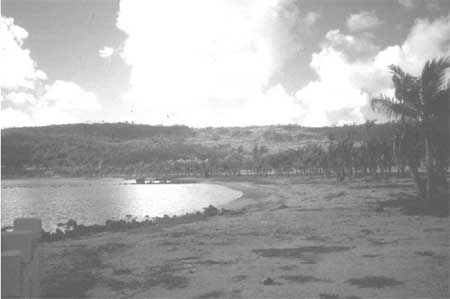
Contemporary photo showing the view along Asan Beach Unit looking
toward Adelup Point (CLI Team/PISO/2001).
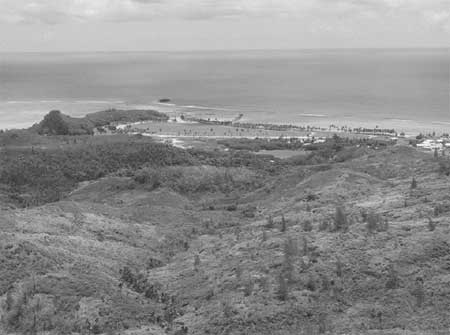
Contemporary photo showing view from Asan Bay Overlook across ridges
to Asan Beach Unit (CLI Team/PISO/2001).
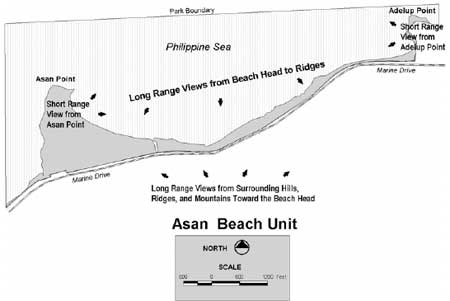
Map illustrating views within the Asan Beach Unit and beyond (CLI
Team/PISO/2003).
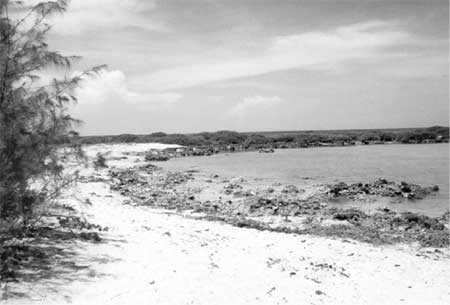
Contemporary photo of view from beach at Ga'an Point toward the south
(CLI Team/PISO/2001).
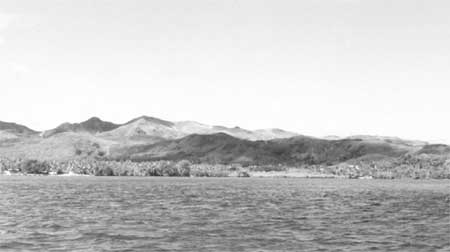
Contemporary photo of view from the Philippine Sea towards the Agat
Beach Unit (CLI Team/PISO/2001).
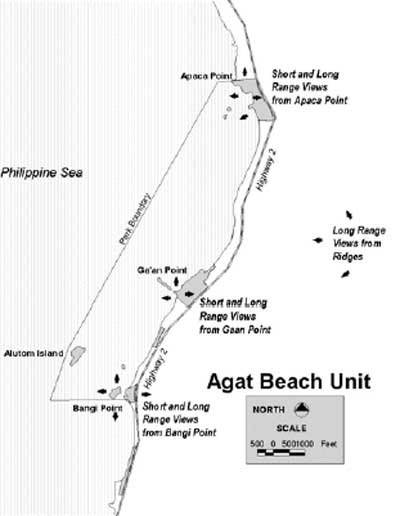
Map illustrating views within the Agat Beach Unit and beyond (CLI
Team/PISO/2001).
| Characteristic Feature |
Type Of Contribution |
LCS Structure Name |
IDLCS Number |
Structure Number |
| Long-Range Views from the Sea and Beaches Toward High Ground (Hills, Ridges and Mountains) and Vice Versa | Contributing | |||
| Short-Range Views from the Philippine Sea Toward the Beaches and Vice-Versa | Contributing | |||
| Short-Range Views in Between the Points (Asan , Adelup, Apaca, Ga'an and Bangi). | Contributing | |||
| <<< Previous | <<< Contents >>> | Next >>> |
wapa/cri/part3b.htm
Last Updated: 03-may-2004